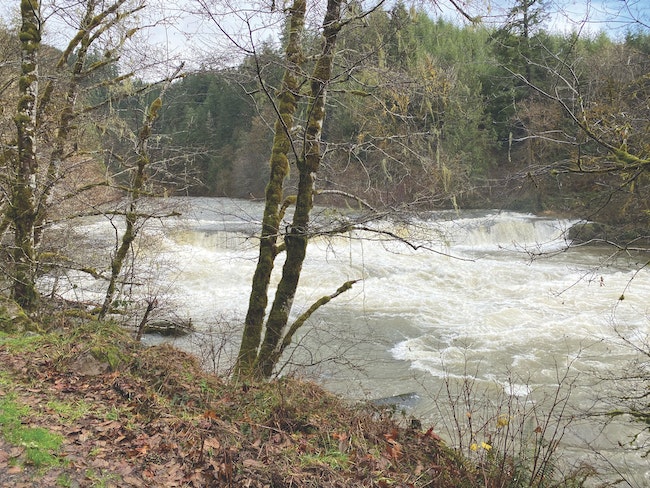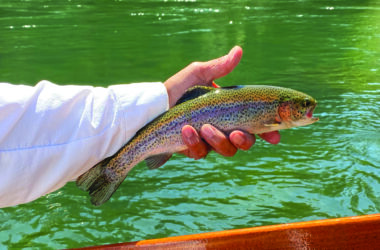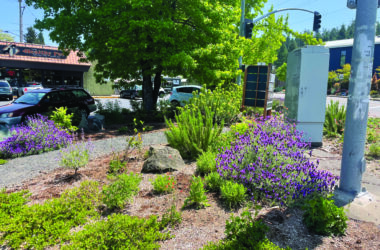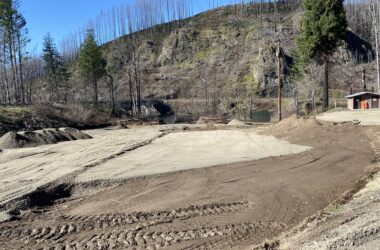 Smith River Falls, on the Smith River, is a tributary of the Umpqua River. Still bank-to-bank with water, and carrying a fair amount of color, it had “turned over” and was falling. The Smith River and almost every other steelhead stream will fall to perfect river levels for the upcoming weekend. FRANK ARMENDARIZ/PHOTO
Smith River Falls, on the Smith River, is a tributary of the Umpqua River. Still bank-to-bank with water, and carrying a fair amount of color, it had “turned over” and was falling. The Smith River and almost every other steelhead stream will fall to perfect river levels for the upcoming weekend. FRANK ARMENDARIZ/PHOTO
It was a trifecta of events that started with a convergence of a series of meteorological conditions that pretty much blanketed the state of Oregon from border to border with snow at Christmas. The snow then changed to rain for New Year’s and came with a real punch as high winds battered many of Oregon’s coastal towns, and downed trees and power lines. It left thousands of residents who live along the coastal strip without electrical power – in some cases for several days. The storms, fueled by tropical moisture, quickly melted away all the lower level snow and as I prepare this week’s Angler’s Log some locations in our state are now dealing with the aftermath of a very significant hydrological event.
Making matters a bit worse is an astrological event, the annual alignment of the moon, Earth and sun that causes the highest tides of the year, and that just happened to come as many coastal rivers were experiencing the highest river flows of the winter season. Bay water backed up, flooding many low-lying areas, then crept onto the streets of some coastal towns. Here in Lane County, Highway 126 between Eugene and Florence was closed for several hours when flooding tidal waters covered a quarter mile of roadway with a couple of feet of water.
Remember that before all the “logic” that shut down river fishing, winter steelhead had made a good early-season showing on streams all up and down the Oregon coast. Good news: By the time this report reaches you, conditions will have greatly settled. River levels will have fallen within the confines of the river bank; in fact, fishing conditions will be about perfect this weekend and could extend into next week. Possibly into late January. …
Under ideal conditions a variety of steelhead lures can be equally effective. If I’m bank-fishing, I usually drift fish, it’s “old-school.” But I enjoy the feel of my gear as it ticks along the river bottom, telegraphed through my rod as I cover the drift. Always anticipating the tattletale hesitation of a steelhead’s bite. From the bank I also spinner fish and use the technique to search for biting fish. Step and cast, step and cast, I cover the water quickly from the top of the drift all the way to the tailout before moving on.
From my drift boat, I prefer to pull diving plugs or a diver-and-bait combination. My favorite bait are sand shrimp on a double hook set up with a spin glow. Bobber and Jig or bobber with plastic worms are very effective and the learning curve is rather modest. Bobber dogging beads is another technique that has become more popular and then there’s “yarnies” that can be saturated with bait scent for drift fishing. The tackle marketplace is flush with products and it can be overwhelming when everyone is telling you they make the “best” steelhead lure. I recommend that anglers pick a technique they enjoy and learn everything they can about it. And I’ll add that if you are not catching steelhead, it’s generally not what you are fishing with, it’s far more likely that it’s where you are fishing. So “cast and step” keep moving.
One last point, I alway prefer to fish down river even when bank fishing. A steelhead will seldom scoot up river when pressured but have no problem slipping back down, so in a sense you are herding them into the tailout where they often make a stand and bite. If they back down to the next hole, they are still in front of you; step and cast, keep searching.
***
In the Willamette Valley, things were pretty messy, too. The Willamette River at Harrisburg rose to the “action stage” last week which is just a few feet below flood stage and at week’s end was still rushing along at about 20K CFS. And that sums up the condition all up and down the valley. Most of the rivers and streams in the Willamette Zone are open year-round but restricted to the use of flies or lures and bait is not allowed. The fishing can be quite good in the winter but it will likely be a week or more before the valley streams settle. Lastly, the ODFW has been stocking urban fisheries through last December. Junction City Pond and Alton Baker Canal were recently planted with rainbows and added to Row River Nature Park. The trout-stocking program will ramp up into spring and will include dozens of other lakes and ponds, culminating with the beginning of the hatchery trout season on the McKenzie at the end of April.
Email: [email protected]
Radio: KDUN, 1030AM








